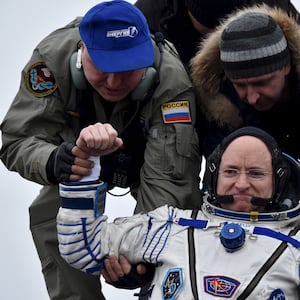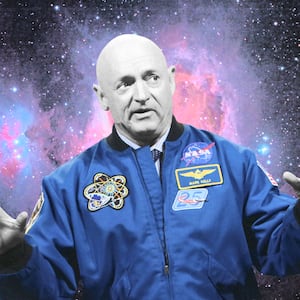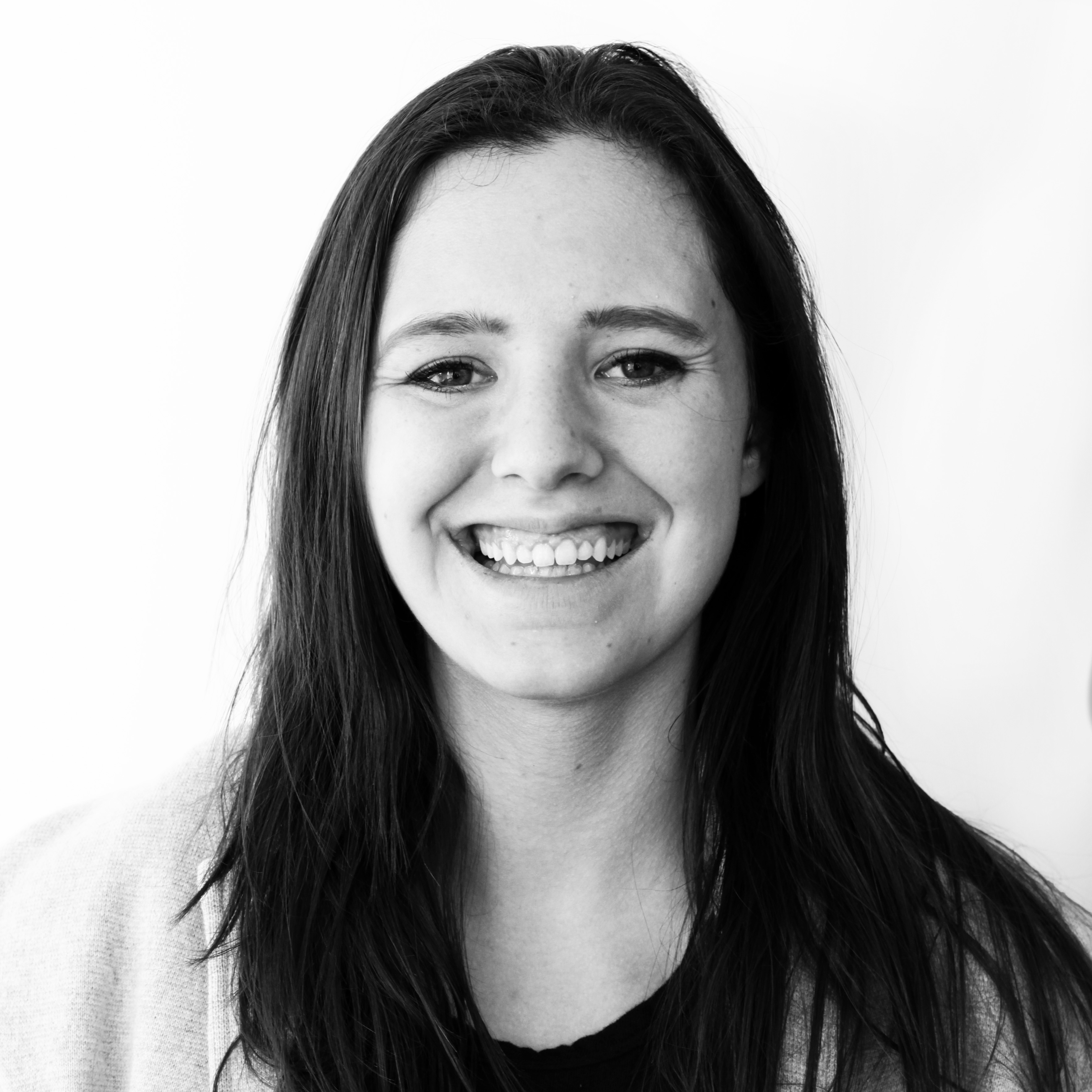Francine Garrett-Bakelman still remembers the day that she held, quite possibly, the most valuable vial of blood of her career. It was March 3, 2016, the day that astronaut Scott Kelly was set to return back to Earth after nearly a year on the International Space Station.
Garrett-Bakelman, now a physician-scientist at the University of Virginia, was handed Kelly’s blood samples soon after he touched down to Earth at Johnson Space Center in Houston. All she could think about was not dropping them.
“It was just a unique situation of handling space-bound material and having the responsibility to make sure the protocol goes well,” she said.
ADVERTISEMENT
“You only get one shot. It was really stressful.”
The samples were part of NASA’s landmark Twins Study, to be published Friday in the journal Science. While Scott Kelly floated 254 miles above on the ISS, his identical twin brother Mark was down on Earth—allowing scientists a unique opportunity to compare the twins’ biological data.
“[Scott made a] tremendous commitment to science, and to our country,” Mark said on a conference call announcing the paper’s results, “and a tremendous act of public service.”
“I got all the glory, and you got a lot of work,” Scott jokingly responded.
The report has good news for aspiring space travelers: Long-term space travel—the kind that would be required for missions to Mars or the many planets beyond—may not be harmful for humans.
Although 559 people have visited space, there have only been eight missions longer than 300 days—and the Kellys are the first pair of twins to undergo a space study.
Ten research teams collected data on the Kellys from samples of their stool, urine, and blood—providing information about everything from the contents of their gut microbiome to the stability of their DNA—for 25 months before, during, and after the ISS mission. While Scott was in space, some of his samples were shot back to Earth on a carrier rocket, while others were preserved for his return.
The study was a first in figuring out how to preserve and send blood back to Earth. For that, the team recruited Garrett-Bakelman, a junior faculty member in 2014 at Cornell Medical School studying a blood cancer, acute myeloid leukemia. That might not seem like anything related to space, but Garrett-Bakelman told The Daily Beast she had a valuable skill: processing blood and analyzing genetic expression in samples—exactly what the experiment with the Kelly twins would require.
“It was totally surreal, a dream come true,” Garrett-Bakelman said.
THE TELOMERE MYSTERY
The report classified 10 biological differences between the twins into low-, medium-, and high-risk categories, depending on the severity of the damage and how long it persisted after Scott came back to Earth.
The majority of Scott’s biomarkers, including his reduced body mass and microbiome composition, quickly returned to normal.
But Garrett-Bakelman and her colleagues noticed something interesting in the telomeres, the caps on our DNA that protect it from damage. On Earth, the longer the telomere, the better a person’s health—because as we age, those telomeres shrink, leaving DNA more susceptible to harm.
Scott Kelly’s telomeres, however, got longer. Even stranger, when Scott Kelly returned to Earth, his telomeres bounced back to their shorter length over time.
Why that happened is a mystery. “It’s one person, and it’s hard to make a conclusion,” Garrett-Bakelman said.
Although average telomere length returned to normal six months after the trip ended, Scott was left fewer telomeres—which could pose a risk for cardiovascular disease and some types of cancer.
Other high-risk changes included a series of ocular symptoms known as spaceflight-associated neuro-ocular syndrome (SANS), cognitive decline, and thickening of the carotid intima-media, a section of an artery wall that NASA’s Stuart Lee described on a conference call ahead of the paper’s release as a “predictor of the 10-year cardiovascular disease risk.”
Despite these findings, the report is optimistic about the future of long-term space travel.
“Given that the majority of the biological and human health variables remained stable, or returned to baseline, after a 340-day space mission, these data suggest that human health can be mostly sustained over this duration of spaceflight,” the report said.
Garrett-Bakelman said that Scott Kelly’s overall health stability is crucial information. “This is really important because it could not have been the case [that his health remained the same],” she said. “It could have been something completely different. Our human body is more adaptable, and living on Earth could be just one interpretation of it. Another interpretation is that he [Scott Kelly] was in the International Space Station and in the confines of the magnetic field of the Earth. Maybe beyond that the story is different.
“But it’s reassuring that most of the things we saw were in the range of what we expected.”
'This is a study of one'
The authors acknowledge that this study has an incredibly small sample size—and that even though the Kellys are identical twins, it’s impossible to attribute every change in Scott as a consequence of his time in space. Mark, for example, got to spend his year playing golf and drinking alcohol, while Scott was confined on a space station where drinking is prohibited.
The International Space Station also poses different risks than, say, Mars, where the radiation is much greater.
“This is a study of one,” Garrett-Bakelman emphasized. Also, “this only speaks to the experience of one Caucasian male. But what if the person is a woman? What if the person is Asian or African-American? What if we don’t know the person’s background? How might that influence their bodies?”
Nevertheless, Garrett-Bakelman said this was a perfect study to kick off our understanding of humans in space because the Kellys are twins.
“The reference of having a twin is very advantageous, so we can eliminate any influence genetics can have on the results,” she said. “From that perspective, it was a great study, the best one to start with actually.”
Outside experts caution, however, that it’s impossible to definitively know that the observed differences between the brothers can be attributed to space travel alone.
“Attributing the changes to Scott’s time in space is nuanced,” Chirag Patel and Chirag Lakhani, co-authors on the largest twins study to date, told The Daily Beast via email. While the Kellys are identical twins, they added, many of the measured biomarkers could also have been influenced by environmental conditions they were exposed to individually before the study began.
“Replicating the findings in other twins will be necessary to conclude whether these findings are in fact due to their time in space or other individual differences,” they added.
We haven’t heard the last of the Kellys. “Right now, this is the initial interpretation and analysis of our data,” Garrett-Bakelman said. “I would anticipate that in the next couple of months or years, there will be additional reports coming out.”
“If you guys ever need me for more science, don’t hesitate to ask,” Mark said on the call.









